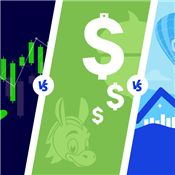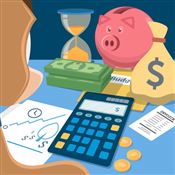How to Invest $20 Wisely
Ad Disclosure: This article contains references to products from our partners. We may receive compensation if you apply or shop through links in our content. This compensation may impact how and where products appear on this site. You help support CreditDonkey by using our links.
$20 may not seem like much money. But there are many investment options open to you, from stocks to real estate. Find out how to start investing with only $20.
 |
| © CreditDonkey |
Yes, and here are the 10 best ways you can invest your $20:
![]()
![]()
![]()
![]()
![]()
![]()
![]()
![]()
![]()
![]()
Think $20 isn't enough to invest? Think again. Even a small amount can grow when you put it in the right places.
Many investment apps now allow you to start with as little as $1, opening the door to stocks, ETFs, real estate, and even bonds. You don't need thousands of dollars to build wealth—just consistency and smart choices.
Read on for the best ways to invest that $20.
Before You Invest
Investing is important, but financial stability should come first. Before putting money into stocks, real estate, or other assets, ensure your finances are in good shape. Here are a few things you should do before you start investing:
- Build an emergency fund
Before investing, make sure you have at least three months' worth of expenses saved. A high-yield savings account is a great place to store emergency funds since it keeps your money safe while earning interest. - Pay off high-interest debt
Debt with high interest, like credit cards or personal loans, can wipe out any investment gains. If your debt carries an interest rate above 6-7%, focus on paying it off first—especially credit cards, which often charge higher interest. - Create a budget for investing
Once debt and savings are under control, budget for investing. Even setting aside $20 can build wealth over time. Choose a percentage of your income to invest regularly and stick to it.
If you don't have an emergency fund, prioritize saving first. Otherwise, investing can help grow your money faster than leaving it in a regular savings account.
10 Best Ways to Invest $20
 |
Investing starts with small steps. With just $20, it's possible to buy stocks, real estate shares, and other assets. This guide breaks down the best ways to get started.
Open a High Yield Savings Account
Risk Level: Very Low | Difficulty: Very Easy
A high-yield savings account (HYSA) is a safe way to grow your money while keeping it accessible. These accounts offer higher interest rates than traditional savings accounts, making them ideal for short-term savings and emergency funds.
Many online banks provide no monthly fees, no minimum deposits, and easy access to funds. However, federal regulations typically limit withdrawals to six per month.
HYSAs are best for risk-free savings and are FDIC-insured, but they don't provide high returns like stocks of ETFs.
High Yield Savings Account - 3.90% APY
- No fees
- $1 minimum deposit
- 24/7 online access
- FDIC insured
Here's how you can get started with HYSAs:
- Check the interest rate: Online banks often offer higher than traditional banks, but rates vary.
- Open an account: Most accounts require $0-$25 to start and take just minutes to set up.
- Deposit $20: Start earning interest while keeping your funds safe and liquid.
Pros + Cons:
|
|
Auto Invest with a Robo-Advisor
Risk Level: Low to Medium | Difficulty: Very Easy
Robo-advisors make investing completely hands-off. They automatically manage your portfolio, investing in stocks, bonds, and ETFs based on your risk tolerance. They also handle portfolio rebalancing and tax-saving strategies to optimize returns.
Many have no account minimums, making them ideal for beginners. You can start with as little as $20 and build a diversified portfolio without managing trades yourself.
Here's how you can get started with robo-advisors:
- Choose a robo-advisor: Popular options include Acorns and Betterment.
- Open an account: Answer a few questions about your risk tolerance and goals.
- Deposit $20: The platform automatically invests in a diversified portfolio.
Pros + Cons:
|
|
Robo Advisor: $20 Investment Bonus
- Open an Acorns account (new users only)
- Set up the Recurring Investments feature
- Have your first investment be made successfully via the Recurring Investments feature
Buy Stocks with Fractional Shares
Risk Level: Medium | Difficulty: Easy
Fractional shares let you invest in top companies with just a few dollars. Instead of buying full shares, you can purchase a fraction of a stock, making it easier to invest in companies like Amazon, Apple, or Tesla without needing hundreds of dollars.
Major brokerages now offer commission-free trading, so small investments won't be eaten up by any fees. Some platforms even let you start with as little as $1.[1]
Here's how you can get started with fractional shares:
- Choose a brokerage: Popular platforms include Robinhood, Fidelity, and Charles Schwab.
- Open an account: Most require basic personal info and a linked bank account.
- Search for a stock: Look for companies that allow fractional shares.
- Invest $20: Buy a small piece of stock and start building your portfolio.
Pros + Cons:
|
|
Yes, many brokerages offer fractional shares, allowing you to buy a portion of a stock instead of a full share. Platforms like Robinhood and Fidelity support this.
Diversify Instantly with ETFs
Risk Level: Low to Medium | Difficulty: Easy
ETFs (exchange-traded funds) let you invest in hundreds of stocks at once. Instead of picking individual stocks, ETFs bundle multiple assets, offering instant diversification with a single purchase.
Popular ETFs track market indexes like the S&P 500, meaning a $20 investment gives you exposure to the 500 largest U.S. companies. Many brokerages support fractional ETF purchases, allowing you to start small.
Here's how you can get started with ETFs:
- Log into your brokerage: You can use popular stock brokers like Robinhood or Webull to purchase ETFs.
- Pick an ETF: Popular choices include SPY (S&P 500) and VTI (Total U.S. Stock Market ETF).
- Invest $20: Buy fractional shares of an ETF and instantly diversify your portfolio.
Pros + Cons:
|
|
Diversified ETFs, bonds, or a high-yield savings account are among the safest options to invest $20. These carry low risk while still offering some return on your money.
Invest in Mutual Funds
Risk Level: Low to Medium | Difficulty: Easy to Moderate
Mutual funds let you invest in a professionally managed fund of stocks and bonds. Unlike ETFs, mutual funds aren't traded on the stock exchange, so you'll have to buy or sell them directly through a brokerage or fund provider.
While many mutual funds require a minimum of $1,000 to $3,000, some have no minimum investment, making them accessible for smaller investors. Just note that mutual funds also typically charge expense ratios.
Here's how you can get started with mutual funds:
- Choose a brokerage: Fidelity, Schwab, and Vanguard offer no-minimum mutual funds.
- Search for a fund: Look for options like Fidelity ZERO index funds, which have no fees or minimums.
- Invest $20: If a fund has no minimum, you can start with a small deposit.
Pros + Cons:
|
|
Invest in Bonds
Risk Level: Low | Difficulty: Easy
Bonds are a low-risk way to earn fixed interest over time. When you invest in a bond, you're essentially lending money to a company or government in exchange for specific periodic interest payments and the return of your principal at maturity.
The Worthy investing platform is the only platform that allows you to invest in bonds with as low as $10, making bonds accessible even with a small budget. These bonds typically fund small businesses and offer a 7% fixed return.
Here's how you can get started with bonds:
- Choose a bond platform: Options include Worthy Bonds or Treasury Direct (for U.S. Treasury Bonds).
- Open an account: Most platforms require basic info and a bank connection.
- Deposit $10-$20: Select a bond and invest to start earning fixed interest.
Pros + Cons:
|
|
Compound Your Earnings with DRIPS
Risk Level: Medium | Difficulty: Moderate
Dividend Reinvestment Plans (DRIPs) let you automatically reinvest dividends into more shares. Instead of receiving cash payouts, your dividends are used to buy additional stock, allowing your investment to compound over time.
DRIPs work best with stable, dividend-paying companies and are a long-term strategy for passive income growth.
Here's how you can get started with DRIPs:
- Choose a dividend-paying stocks: Look for stocks or ETFs that pay regular dividends. Most brokerages provide a dividend yield percentage
to help you identify income-generating investments.
- Enable DRIP in your brokerage account: Most brokers, like Robinhood and Fidelity, let you automatically reinvest dividends by enabling the DRIP feature in your account settings.
- Invest any amount: Since fractional shares also earn dividends, there's no minimum investment required. Even small amounts are reinvested into more shares over time.
Pros + Cons:
|
|
Purchase Real Estate
Risk Level: Low | Difficulty: Easy
How much is $20 worth? Enough to invest in real estate.With Fundrise, you can get into real estate with just $10. Click on your state to start investing in high-quality assets.
Real estate investing isn't just for the wealthy. Platforms like Fundrise offer real estate crowdfunding, allowing investors to start with as little as $10 by pooling money with others.
Returns come from rental income and property appreciation—just like traditional real estate investing—without the need to own property outright.
Here's how you can get started with real estate crowdfunding:
- Create a Fundrise account: Fundrise lets you start with as little as $10.
- Pick an investment: You can invest in residential, commercial, or diversified portfolios.
- Deposit $20: Start earning passive income.
Pros + Cons:
|
|
Real Estate Investment: Invest in Real Estate with $10+
- Only $10 minimum investment
- Get a diversified portfolio of real estate projects across the US
- Open to all investors
Optimize Your 401(k)
Risk Level: Varies (Depends on Asset Allocation) | Difficulty: Easy
A 401(k) is one of the easiest ways to build wealth for retirement. These employer-sponsored plans let you invest pre-tax income, meaning you pay no taxes on contributions until withdrawal.
Many employers offer a contribution match, which is essentially free money for your retirement. However, you need to actively manage your 401(k) to ensure it aligns with your long-term financial goals.
Here's how you can get started with optimizing your 401(k):
- Check your employer's match policy: Contribute at least enough to get the full match.
- Review your investment options: Choose a mix of stocks, bonds, and target-date funds based on your risk tolerance.
- Increase contributions over time: Even small increases (1% per year) can lead to significant growth.
Pros + Cons:
|
|
Invest in Yourself
Risk Level: None | Difficulty: Easy
One of the best investments is in your own skills and knowledge. Developing new skills can increase earning potential, open career opportunities, or create new income streams.
For example, online courses on platforms like Udemy, Coursera, and Skillshare offer affordable training in areas like coding, graphic design, marketing, and investing—many for under $20. Learning a high-demand skill can pay off exponentially over time.
Here's how you can get started on investing in yourself:
- Identify a skill to improve: Look for career-boosting or side-hustle skills like coding, finance, or digital marketing.
- Take an online course: Platforms like Udemy or Coursera offer courses for $20 or less.
- Apply what you learn: Use new skills to increase job opportunities, start freelancing, or improve a business.
How Much Can You Earn With $20?
Can $20 really make a difference? The answer depends on where you invest and how long you let it grow.
Some investments compound over time, turning small contributions into much larger sums.
Yes, investing $20 a week can add up significantly over time. With compound growth, consistent investments can turn into thousands of dollars over the years.
How to Maximize Your Investment
Making smart investment choices is important, but how you invest can have an even bigger impact on your returns. Here are key strategies to help your money grow efficiently.
- Minimize fees
Investment fees, even small ones, add up over time and can significantly reduce your returns. Always look for low or no trading commissions, low expense ratios, and no unnecessary account fees. - Invest consistently
Successful investors don't try to time the market—they invest regularly, no matter what the market is doing. This strategy, called dollar cost averaging, helps smooth out market fluctuations. - Diversify your portfolio
Spreading your investments across different assets helps reduce risk. A well-balanced portfolio can provide steady growth while protecting against losses. - Reinvest your earnings
Instead of withdrawing dividends or interest, reinvest them to buy more shares. This allows your investments to compound faster and accelerate long-term growth. - Think long-term
The biggest gains in investing come from time, not timing. The earlier you start, the more time your money has to compound and grow exponentially. - Keep emotions out
Market ups and downs are normal, but emotional reactions can lead to bad decisions like panic selling or chasing quick gains. Stick to your strategy and focus on long-term growth.
Investment Calculator
Even small investments can build wealth over time—especially when compounded. Use the calculator below to see how much your money could grow with different interest rates, timeframes, and contribution amounts.
Here's how to use the calculator:
- Enter your initial investment
- Set a monthly contribution
- Choose how many years to grow
- Adjust the interest rate
- Select compounding frequency
From there, click "Calculate" and you'll see your projected final balance, total contributions, and interest earned.
How to Pick an Investment Option
Not all investments are the same, and choosing the right one depends on your financial goals, risk tolerance, and time horizon. Here are the key factors to consider before investing your money:
- Risk tolerance
All investments carry risk. Stocks offer high growth but can fluctuate, while bonds and savings accounts provide stability with lower returns. Choose based on your comfort level with potential losses. - Time horizon
If you need the money soon, safer options like high-yield savings accounts or short-term bonds are best. Long-term investors can take on more risk with stocks, ETFs, or real estate since they have time to recover from market downturns. - Liquidity needs
Some investments, like stocks and savings accounts, can be accessed quickly. Others, like real estate or long-term bonds, take time to sell. If you need your money soon, choose investments that are easy to cash out. - Expected returns
Stocks and ETFs generally offer higher long-term returns but come with risk. Bonds are safer but yield less. Savings accounts offer security but may not keep up with inflation. Consider what balance of risk and reward fits your needs. - Tax implications
Some investments, like 401(k)s and IRAs, offer tax advantages. Others, like stocks and real estate, may trigger capital gains taxes. Consider tax-efficient options to maximize long-term growth.
Bottom Line
Investing money doesn't require thousands of dollars—even $20 is enough to start building wealth. With options like fractional shares, ETFs, robo-advisors, and high-yield savings accounts, beginners can grow their money with minimal effort.
The key to success is consistency. A one-time $20 investment won't make you rich, but investing small amounts regularly can lead to significant long-term gains.
Start today with an investment that fits your goals. Over time, even small investments can create real financial growth.
References
- ^ Robinhood. How to start investing for as little as 1 dollar, Retrieved 03/09/2025
- ^ Fidelity. We're raising the bar on value, Retrieved 02/12/2025
Write to Anna G at feedback@creditdonkey.com. Follow us on Twitter and Facebook for our latest posts.
Note: This website is made possible through financial relationships with some of the products and services mentioned on this site. We may receive compensation if you shop through links in our content. You do not have to use our links, but you help support CreditDonkey if you do.
Fundrise, LLC ("Fundrise") compensates CreditDonkey Inc for new leads. CreditDonkey Inc is not an investment client of Fundrise.
|
|
| ||||||
|
|
|











